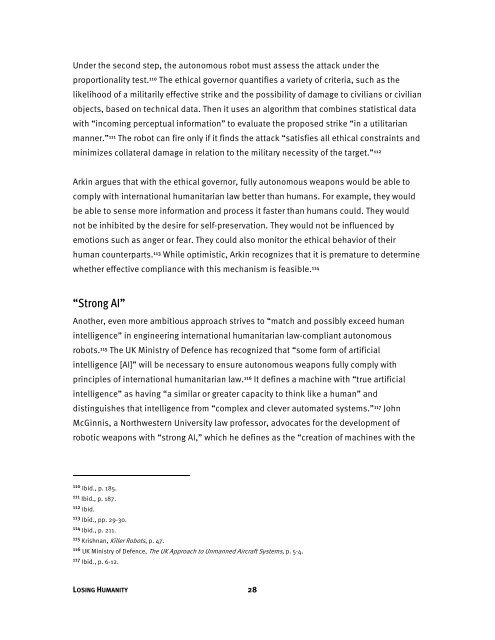arms1112_ForUpload
arms1112_ForUpload
arms1112_ForUpload
Create successful ePaper yourself
Turn your PDF publications into a flip-book with our unique Google optimized e-Paper software.
Under the second step, the autonomous robot must assess the attack under theproportionality test. 110 The ethical governor quantifies a variety of criteria, such as thelikelihood of a militarily effective strike and the possibility of damage to civilians or civilianobjects, based on technical data. Then it uses an algorithm that combines statistical datawith “incoming perceptual information” to evaluate the proposed strike “in a utilitarianmanner.” 111 The robot can fire only if it finds the attack “satisfies all ethical constraints andminimizes collateral damage in relation to the military necessity of the target.” 112Arkin argues that with the ethical governor, fully autonomous weapons would be able tocomply with international humanitarian law better than humans. For example, they wouldbe able to sense more information and process it faster than humans could. They wouldnot be inhibited by the desire for self-preservation. They would not be influenced byemotions such as anger or fear. They could also monitor the ethical behavior of theirhuman counterparts. 113 While optimistic, Arkin recognizes that it is premature to determinewhether effective compliance with this mechanism is feasible. 114“Strong AI”Another, even more ambitious approach strives to “match and possibly exceed humanintelligence” in engineering international humanitarian law-compliant autonomousrobots. 115 The UK Ministry of Defence has recognized that “some form of artificialintelligence [AI]” will be necessary to ensure autonomous weapons fully comply withprinciples of international humanitarian law. 116 It defines a machine with “true artificialintelligence” as having “a similar or greater capacity to think like a human” anddistinguishes that intelligence from “complex and clever automated systems.” 117 JohnMcGinnis, a Northwestern University law professor, advocates for the development ofrobotic weapons with “strong AI,” which he defines as the “creation of machines with the110 Ibid., p. 185.111 Ibid., p. 187.112 Ibid.113 Ibid., pp. 29-30.114 Ibid., p. 211.115 Krishnan, Killer Robots, p. 47.116 UK Ministry of Defence, The UK Approach to Unmanned Aircraft Systems, p. 5-4.117 Ibid., p. 6-12.LOSING HUMANITY 28




